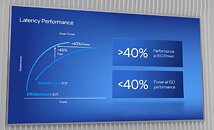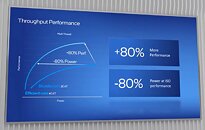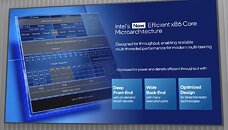Thursday, August 19th 2021

Intel's Secret Sauce at Catching Up with AMD Core Count is the Gracemont E-core and its Mind-boggling Perf/Watt
When early benchmarks of the Core i9-12900K "Alder Lake-S" processor showing performance comparable to AMD's top 16-core Ryzen 9 5950X surfaced, we knew something was up. 8 Intel P-cores and 8 E-cores, are able to match 16 "Zen 3" cores that are all performance cores. Apparently Intel is able to turn its P-core deficit around by taking a wacky approach. First, the 8 "Golden Cove" P-cores themselves offer significantly higher IPC than "Zen 3." Second, the 8 "Gracemont" E-cores aren't as "slow" as conventional wisdom would suggest.
Intel in its Architecture Day presentation put out some astounding numbers that help support how 8 big + 8 little cores are able to perform in the league of 16 AMD big cores. Apparently, on "Alder Lake-S," the 8 "Gracemont" E-cores enjoy a lavish power budget, and are able to strike an incredible performance/Watt sweet-spot. Intel claims that the "Gracemont" E-core offers 40% higher performance at ISO power than a "Skylake" core (Intel's workhorse P-core for desktops until as recently as 2020); which means it consumes 40% less power at comparable performance.A "Gracemont" core hence doesn't end up too far behind "Skylake." The combination of high-IPC P-cores and "fairly fast" E-cores are hence able to attain performance levels comparable to 16 "Zen 3" cores. There are some limitations, though. For starters, "Gracemont" cores don't support HyperThreading, unlike "Skylake," and have a reduced ISA instruction-set compared to the P-cores.
Intel in its Architecture Day presentation put out some astounding numbers that help support how 8 big + 8 little cores are able to perform in the league of 16 AMD big cores. Apparently, on "Alder Lake-S," the 8 "Gracemont" E-cores enjoy a lavish power budget, and are able to strike an incredible performance/Watt sweet-spot. Intel claims that the "Gracemont" E-core offers 40% higher performance at ISO power than a "Skylake" core (Intel's workhorse P-core for desktops until as recently as 2020); which means it consumes 40% less power at comparable performance.A "Gracemont" core hence doesn't end up too far behind "Skylake." The combination of high-IPC P-cores and "fairly fast" E-cores are hence able to attain performance levels comparable to 16 "Zen 3" cores. There are some limitations, though. For starters, "Gracemont" cores don't support HyperThreading, unlike "Skylake," and have a reduced ISA instruction-set compared to the P-cores.



49 Comments on Intel's Secret Sauce at Catching Up with AMD Core Count is the Gracemont E-core and its Mind-boggling Perf/Watt
If, because how workload dependant is this :) Its interesting nonetheless.
Well done and I hope they stop their old habits which die hard. Intel can renovate itself they hired Jim Keller for heaven's sake - they better develop system level changes! Intel with all its might does not need to be the slow adopter!
Neither core has AVX? Thats.... special.
Here's what I read...
"Gracemont" is Intel's first low-power core to support AVX, AVX2, and AVX-VNNI instruction sets. "Golden Cove" features a more lavish ISA that includes AVX-512 (select client-relevant instructions)."
PS: Nvidia didn't beat 3dfx by featuring the same supersampling, Intel didn't beat IBM with the same level of performance...
AVX-512 seems to be completely disabled on Alder Lake
Not too much of a loss if anyone asks me.
For me it's got too damn many little cores, I mean who needs 16 small better than Skylake core's to run the backend and wants just 8 big cores for in focus gaming?!.
Surely 4/8 small OS cores and 16 Big cores is what I might have bought into not the vice versa version they're peddling.
PS: I have full confidence in him turning the power grab away from the marketing team(Product Assurance HR). Where in the world does stupid HR people know better than the engineers?
And apparently they migrated the only actually marketed component of 512 to AVX2 (VNNI). Seems like a big win, obvious AVX512 memeing aside due to Intel marketing, don't see how this is a bad thing.
That said, comparing Gracemont to Coffee Lake/Comet Lake seems a bit sus, yes it's going to be a big jump in efficiency for Intel but Skylake was only relevant for so long because it was pushed to 5-5.3GHz. Yeah Gracemont is nice and efficient, but it runs at what, 3.0GHz? Not sure how they're expected to make up the MT perf gap with AMD, push Golden Cove even harder with the power budget freed from Gracemont? :confused:
I can throw 32 core's in my age's old pc now and they're offering a revolutionary 24?!, FFS is they're PR team on crack.
Anyone can buy 128 thread CPU today too so yeh go Intel.
If I were AMD I'd just stack 8 arm core's on and work some driver magic and have any arm x86 app run on the most effective core type, have at apple and co while they're at it, those arm core's could run back end tat emulated.
Gracemont doesn't need marketing lies and deception, it's a frickin' amazing bit of ultra-dense computing power that will never beat Skylake in a fair fight and isn't supposed to. It's supposed to run all the background crap at low power consumption and free up the Raptor Cove cores to focus on the threads that need maximum performance. In my experience of Denverton servers, those Tremont cores feel very much like Core2 era processing power - except today they're running 16 cores at 1.5W per core, rather than the Core2 at 65W for just a couple of cores.
Seeing a rack stacked with half-U Supermicro Atom 16C/128GB mini servers each with dual 10GbE connectivity is bonkers. A single 42U rack holds enough compute, RAM, and network bandwidth to host VDI workstations for ~1000 people and yet the whole rack is short-depth and uses barely 2KW. If that doesn't impress you then I guess you're just not that into servers.